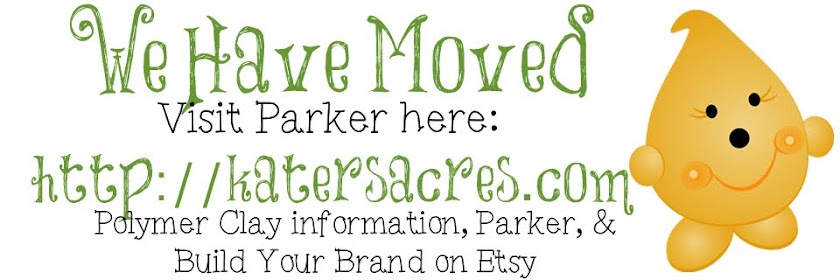
GETTING TO KNOW POLYMER CLAY

Part 1:
An Introduction to Polymer Clay
Many of my customers ask me "what is polymer clay." While it is easy to explain, the uses, techniques, and types of polymer clay available are wide-spread! We are going to do a four part series on "Getting to Know Polymer Clay." This is the first of four parts, a basic introduction to polymer clay.
WHAT IT IS: Polymer clay is a sculptable material based on the polymer polyvinyl chloride (PVC). It usually contains no clay minerals, and is only called "clay" because its texture and working properties resemble those of mineral clay. It is sold in craft, hobby, and art stores, and is used by artists, hobbyists, and children.
WHAT IT CONTAINS: Polymer clays all contain a basis of PVC and one or more of several kinds of liquid plasticizer. Pigments may be added to the translucent base to create a variety of colors, along with small amounts of kaolin or white china clay or other opaquing agents where opacity is desired. Mica may be added to simulate pearlescent and metallic effects.
HOW IT WORKS: Traditional polymer clay hardens by curing at temperatures created in a typical home oven, generally at 265 to 275 °F (129 to 135 °C), for 15 minutes per 1/4" (6 mm) of thickness, and does not shrink or change texture during the process. When properly conditioned and cured, most clays create items that will not break if dropped or normally stressed. Cured pieces may have additional layers or enhancements added and be re-cured with no ill effect. As long as the maximum curing temperature is not exceeded, there is no limit to the number of times a piece can be re-cured. After it has cured, the clay surface can be left as is, sanded and buffed, or finished with a water-based varnish.
TYPES: Leading brands of polymer clay include Fimo; Sculpey, Premo and Studio by Sculpey, created by Polyform Products; Cernit; Formello; Modello; and Kato Polyclay. Though the brands differ slightly in properties such as plasticity, translucence, curing temperature, and flexibility when cured, most are suited to a variety of applications. Specialty formulations include clay that remains permanently flexible when cured, eraser clay, and colorless and tinted liquid "clays" that can be used as slips, glazes, and adhesives.
VARIETY: Polymer clay is available in many colors. "Special-effect" colors such as translucent, fluorescent, phosphorescent, mica-containing "pearls" and "metallics," and variegated "stone" colors containing contrasting fibers are also available. Standard colors, which vary from brand to brand, can be mixed to create a virtually infinite range of custom colors, gradient blends, and other effects.
Polymer clay can be colored with other media. Paint, ink, colored pencil, chalk, metallic or mica-containing powder, metal leaf and foil, glitter, and embossing powder can be applied to the surface. The same materials also can be mixed in as inclusions; this is often done with translucent clay. When acrylic paint is cured onto the surface, it forms a permanent bond with the surface.
TOOLS & SUPPLIES: Few tools are essential for use with polymer clay, and these can often be found around the house. The most widely used cutting tools are tissue blades, which are extremely thin and sharp, though craft knives and other blades can be used. A pasta machine is often used to create sheets of uniform thickness, to mix colors, to condition the clay, and to create patterned sheets. A "clay gun" or extruder with interchangeable die plates allows creation of lengths of clay in a variety of uniform sizes and shapes. Most molding and modeling tools used by traditional sculptors are suitable for polymer clay, but artists often create improvised cutting, piercing, molding, and texturing tools from items used in sewing, cooking, woodworking, and paper crafts.
What can you use polymer clay for?
Polymer clay is relatively new to the art world. While it can be used alone as sculptures, it can also be added to glass, metal, or pottery. The uses for polymer clay are literally endless! The PCETeam has many different kinds of polymer clay artists, from people who sculpt, to those who make jewelry, home decor, and yes even painting with clay!
JOIN US AGAIN SOON FOR OUR FOLLOW-UP POST:

No comments:
Post a Comment